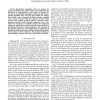Free Online Productivity Tools
i2Speak
i2Symbol
i2OCR
iTex2Img
iWeb2Print
iWeb2Shot
i2Type
iPdf2Split
iPdf2Merge
i2Bopomofo
i2Arabic
i2Style
i2Image
i2PDF
iLatex2Rtf
Sci2ools
TIFS
2010
2010
Quantitative Structural Steganalysis of Jsteg
Quantitative steganalysis strives to estimate the change rate defined as the relative number of embedding changes introduced by steganography. In this paper, we propose two new classes of quantitative steganalysis methods for the steganographic algorithm Jsteg. The first class obtains the changerate estimate using a maximum likelihood estimator equipped with a precover model. While this approach provides better accuracy than existing structural attacks, it becomes computationally intractable with increasing complexity of the cover model. The second class of methods computes the change-rate estimate by minimizing an objective function constructed from a heuristically-formed zero message hypothesis. The advantage of this heuristic approach is a low implementation complexity and modular architecture that allows flexible incorporation of higherorder statistics of DCT coefficients. The proposed methods are experimentally compared with current state-of-the-art methods.
Education | Quantitative Steganalysis | Quantitative Steganalysis Methods | Steganographic Algorithm Jsteg | TIFS 2010 |
| Added | 22 May 2011 |
| Updated | 22 May 2011 |
| Type | Journal |
| Year | 2010 |
| Where | TIFS |
| Authors | Jan Kodovský, Jessica J. Fridrich |
Comments (0)

